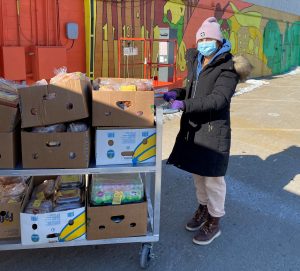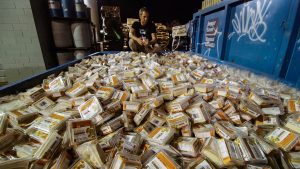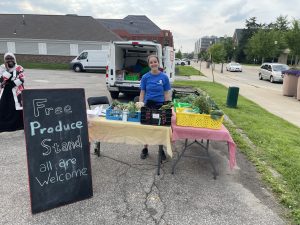Film reflection with the food rescue team
Table to Table staff discuss documentary “Just Eat It: A Food Waste Story”
A bell pepper seedling blooms on the screen as Simple Minds’ “Don’t You (Forget About Me)” begins to play. The camera follows one pepper as it forms on the plant, is picked, and is transported to a processing facility. It’s placed in a box with several other peppers, shipped to a grocery store, set on the produce shelf, and finally purchased by a lucky consumer.
After its months-long journey it is placed in that person’s refrigerator. We watch as the pepper turns yellow, then orange and red – then it loses its shape as it rots on the shelf, forgotten.
As we watch, every member of the Table to Table team groans or exclaims once it becomes clear no one is going to eat that beautiful pepper. For a team that spends all their working hours rescuing food from such a fate, it’s almost painful to watch.
In Just Eat It: A food waste story, filmmakers Jen and Grant decide that for six months, they will only eat food that was headed for the waste stream. They source this food by asking grocery stores if they can look through items that have been culled from shelves, or by going straight to the dumpsters behind stores to see what’s available. T2T staff gathered to preview the film together before we showed it on the big screen at our drive-in movie night. Here’s our take.
It is important to note that T2T rescues food before it reaches dumpsters. In the model we use, food donor partners set aside good food that otherwise would have been tossed for a variety of reasons unrelated to whether the food was still edible: there was an error in ordering and they have too much, containers are mislabeled, or it’s “ugly” produce or getting close to the “sell by” date and consumers aren’t likely to buy it. Table to Table volunteers collect this food from stores and deliver it to hunger relief partners within a few hours.

At least one-third of all food produced worldwide isn’t eaten. Just Eat It is an attempt at answering the questions, “What impact does this have? Why does the world let so much food go to waste?”
Wasted food affects our climate. Once large amounts of food are compacted together in landfills and rotting, they produce methane. “Methane is a potent greenhouse gas MANY times more effective than carbon dioxide at trapping heat in the atmosphere – and the primary contributor to the formation of ground-level ozone,” Nora Garda, T2T Gleaning Coordinator, observes after watching the film.
Molly Suter, Local Foods Recovery Specialist, adds, “Through wasting food, we are directly contributing to the quickly changing climate of our own planet.”

Resources that went into producing the food are also wasted. Several T2T staff were shocked to learn that throwing away one hamburger is equivalent in water usage to taking a 90 minute shower. “The water used to produce the total amount of food the world throws away can provide water for 500 million people,” Molly says, which then raises her question, “What other overlaps with social issues exist with food waste?”
“It’s an issue of environmental justice in terms of who has access to the food in the first place, AND people who need this water and this good food often don’t have access to it,” Lillian Poulsen, Food Access & Equity Training Specialist, notes. “In my role, I focus on access and equity in terms of education for our partners and the volunteers with whom they work. The issue of environmental justice is a key facet of what we do as an organization, and the amount of food wasted in our country, state, county, and community directly affects the lives of poor and marginalized communities where food insecurity is most prevalent.”
The documentary states that the majority of food waste comes from households, pointing out that generally individuals waste up to a quarter of what they buy from the store. The documentary demonstrates with a particularly effective illustration: “Imagine walking out of the grocery store with four bags loaded with food and you drop one in the parking lot on the way to your car…and you just leave it there.”

What contributes to this level of waste?
One issue pointed out by Nicki Ross, Executive Director, is “this idea that we determine what we will eat by first asking, ‘what do I feel like eating?’ She adds, “My family didn’t always have a lot growing up and one of the skills we developed is making a pretty good meal with whatever was left in the fridge or cupboard. ‘Do I really want that?’ is partially the product of a wealthy society.”
“It’s important to highlight how our culture views food in terms of abundance,” Lillian says. “The movie talked about how it’s seen as a failure in our culture when food runs out [at a party, for example], and wasting food isn’t taboo.”
“In the end I was disheartened to think about the waste that is created by me as a consumer and the way that stores order and stock food to appease the consumer, from rejecting perfectly good fruit because the shape is not ‘perfect’, to ordering way more than needed so that the shelves always look full,” Jared Long, Volunteer Coordinator, says.
Nicki adds, “It’s not uncommon for food sellers to have this opinion. They don’t want to ‘ruin their image’ by offering ‘ugly’ or discounted products. Interesting fact: Retailer standards far exceed that of the state for food safety/quality reasons.” Retailers who donate food are also protected under the Bill Emerson Food Donation Act.
“How can we change consumer/grocery store standards so grocery stores don’t only display ‘perfect-looking’ products and consumers don’t insist on only that?” Celia Eckermann, Bookkeeper, asks. The only item required by the FDA to include Best By dates for safety is infant formula. She continues, “How do we educate the public on the meaning of those dates and get manufacturers to adjust the wording so grocery stores and consumers don’t waste dated products?” (Learn more about how to decode Best By, Use By, and Sell By dates here.)
Fruits and vegetables are the most-wasted food group. What stood out from the film to Alyssa Schaeffer, Local Foods Access Specialist who coordinates free produce stands, was “how much food gets wasted at the beginning of the food system cycle. A lot of food gets left in the field, which is where T2T gleaning and free produce stands come into play.”

In the film, a celery farmer is shown letting half the cut celery go to waste out in the field because it won’t fit in the bags it’s sold in and it isn’t economical to pay for labor costs to collect it. A situation like this is where T2T comes to the rescue, literally. We send teams of volunteers to local farmers’ fields to glean extra produce at no charge. Farmers don’t want their produce to be wasted; there is just no financial or time incentive to harvest everything they produce.
“I wish every community had a Table to Table,” Molly adds. “I wish everyone was more cognizant of the tremendous amount of food wasted and how it connects to other issues.”
T2T recovers over 2 million pounds of food each year in Johnson County and connects this abundance to the great need in our community. You can help! Learn more about volunteering, or make a donation. Are you a gardener? Bring your extra produce to our office and we’ll distribute it.
Missed our screening of “Just Eat It?” You can watch it here – then let us know what you think! Send your observations and questions to us at info@table2table.org.

